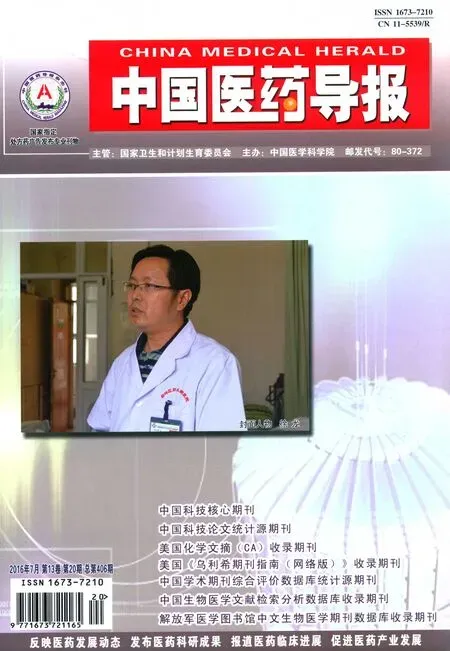不同酒種對血清Hcy及頸動脈粥樣硬化的影響
謝華寧 郭 宏
1.陜西省中醫醫院心內科,陜西西安710003;2.哈爾濱醫科大學附屬第一醫院心內科,黑龍江哈爾濱150010
不同酒種對血清Hcy及頸動脈粥樣硬化的影響
謝華寧1郭 宏2
1.陜西省中醫醫院心內科,陜西西安710003;2.哈爾濱醫科大學附屬第一醫院心內科,黑龍江哈爾濱150010
目的探討飲用白酒及啤酒對血清同型半胱氨酸(Hcy)及頸動脈粥樣硬化的影響。方法選擇2013年10月~2016年1月陜西省中醫醫院診治的頸動脈粥樣硬化男性患者217例,其中有大量飲酒史141例,無飲酒史76例,依據飲酒種類分為3組,白酒組(68例)、啤酒組(73例)、不飲酒組(76例)。分別測定血清同型半胱氨酸(Hcy)和頸動脈斑塊檢出率。結果白酒組和啤酒組血清Hcy及斑塊檢出率較不飲酒組均明顯升高,差異有統計學意義(P<0.05)。啤酒組較白酒組血清Hcy及斑塊檢出率明顯降低,差異有統計學意義(P<0.05)。結論大量飲酒不論白酒或啤酒均導致血清Hcy升高,動脈粥樣硬化病變加重,飲用啤酒較白酒對血清Hcy、頸動脈粥樣硬化影響小。
飲酒曰同型半胱氨酸曰頸動脈粥樣硬化
隨著生活方式的改變,飲酒在日常生活中越來越普遍,它對健康的影響也越來越受到關注。研究顯示飲酒可干擾同型半胱氨酸(Homocysteine,Hcy)代謝[1-2],然而不同酒種對Hcy的影響一直存在爭議[3-5]。作為心腦血管疾病獨立危險因素的Hcy,已成為一個新的評估酗酒危害的不可忽視的生化指標[6]。本研究探討飲用白酒及啤酒對血清Hcy及頸動脈粥樣硬化的影響。
1 資料與方法
1.1 一般資料
選擇2013年10月~2016年1月陜西省中醫醫院診治的頸動脈粥樣硬化男性患者217例,其中有大量飲酒史1年以上141例[飲酒種類包含白酒和啤酒,大量飲酒標準:(美國)國家防止酒精中毒和酒精濫用研究所(NIAAA)規定1飲酒單位(1杯)為0.5 oz酒精(1 oz=28.35 g),大量飲酒量定為每日酒精攝入量≥24 g[9],無飲酒史76例,年齡30~80歲,平均(57.24± 10.34)歲,所有患者均符合頸動脈粥樣硬化診斷標準[7-8]:頸動脈內膜中層厚度(cIMT)>0.9 mm和/或動脈粥樣硬化斑塊,并排除原發性及繼發性高血壓病、糖尿病、甲狀腺功能減退癥,嚴重心、腦、肝、腎功能等嚴重并發癥,有嚴重的急性感染或代謝紊亂的患者。根據飲酒種類分為白酒組(68例)、啤酒組(73例)、不飲酒組(76例)。白酒組平均每日酒精攝入量90%以上來自白酒,啤酒組平均每日酒精攝入量90%來自啤酒。
1.2 方法
1.2.1 收集患者的一般資料及生化指標檢查包括姓名、年齡、身高、體重指數(BMI)、家族史、既往史。空腹8 h后抽取肘靜脈血10 mL,應用全自動生化分析儀檢測Hcy、空腹血糖、血脂水平及肝腎功能等。
1.2.2 頸動脈彩超檢查由專人操作Agilent sonos 5500彩色多普勒超聲診斷儀,二維探頭頻率10 MHz,血流聲束<60℃,取樣容積2.0 mm。檢查前患者休息10 min,取平臥位,雙肩墊枕,頭部偏向檢查對側,充分暴露頸部。沿胸鎖乳突肌外緣縱切掃查,依次顯示頸總動脈、頸內動脈、頸總分叉、頸外動脈和椎動脈。取樣部位包括頸總動脈的遠端(頸內、頸外動脈分叉水平連線下方1.5 cm處)、頸內動脈起始部(分叉水平上方1~1.5 cm處)和頸動脈分叉處(即球部)。評價標準:cIMT>0.9 mm判定為內膜增厚,≥1.2 mm或突向管腔內局灶性回聲結構超過相鄰區50%為斑塊。
1.3 統計學方法
采用統計軟件SPSS 20.0對數據進行分析,正態分布計量資料以均數±標準差(x依s)表示,多組間比較采用One-Way ANOVA,兩兩比較采用SNK-q檢驗。計數資料以率表示,采用χ2檢驗。以P<0.05為差異有統計學意義。
2 結果
2.1 一般資料比較
三組年齡、吸煙、體重指數、血清總膽固醇、三酰甘油、低密度脂蛋白膽固醇、肌酐、尿酸、谷丙轉氨酶等基線資料比較,差異均無統計學意義(孕>0.05)。見表1。
2.2 三組血清Hcy堯斑塊檢出率結果
白酒組和啤酒組血清Hcy及斑塊檢出率較不飲酒組均明顯升高,差異有統計學意義(P<0.05)。啤酒組較白酒組血清Hcy及斑塊檢出率明顯降低,差異有統計學意義(P<0.05)。
表1 三組一般資料比較(依s)

表1 三組一般資料比較(依s)
組別例數年齡(歲)吸煙(%)體重指數(kg/m2)三酰甘油(mmol/L)血清總膽固醇(mmol/L)低密度脂蛋白膽固醇(mmol/L)肌酐(μmol/L)尿酸(μmol/L)谷丙轉氨酶(U/L)白酒組啤酒組不飲酒組F值P值68 73 76 57.06±10.12 58.15±10.76 56.51±10.19 0.27>0.05 18(26.47)20(27.40)21(27.63)0.65>0.05 26.03±2.87 25.23±3.87 24.23±3.71 0.17>0.05 2.01±0.52 1.94±0.41 1.97±1.06 1.36>0.05 4.98±1.19 4.91±1.13 4.88±1.05 2.84>0.05 2.60±0.71 2.56±0.55 2.56±0.55 0.63>0.05 65.45±14.18 66.13±11.58 63.73±15.58 0.43>0.05 353.45±91.13 346.15±106.81 390.59±103.39 0.36>0.05 20.42±10.12 17.4±9.23 18.4±7.23 0.57>0.05

表2 三組血清Hcy、斑塊檢出率比較
3 討論
Hcy是一種是所有細胞中產生的含硫的非必需氨基酸,是葉酸和蛋氨酸一個通常的代謝產物。由環境營養及遺傳因素干擾Hcy代謝是形成高同型半胱氨酸血癥(hyperhomocysteinemia,Hhcy)的主要原因。大量報道顯示[10-12],在即使沒有引起Hhcy的其他因素下,適量飲酒可導致血清Hcy升高,血清Hcy與飲酒量呈正相關。然而也有些研究顯示適量飲酒后卻未發現血清Hcy升高,這些研究對象主要以飲用啤酒為主[13-14],故提示不同酒種對Hcy的影響不同。本研究報道了不同酒種干擾Hcy代謝異常對心血管疾病的影響。
本研究發現大量飲酒患者,不論飲用白酒還是啤酒血清Hcy水平均明顯高于不飲酒組(P<0.05),同時發現啤酒組較白酒組血清Hcy明顯降低(P<0.05)。飲酒可能通過干擾B族維生素代謝、影響5,10-亞甲基四氫葉酸還原酶活性及抑制蛋氨酸合酶活性等機制干擾Hcy代謝,導致血清Hcy升高[15]。有報道顯示補充足量B族維生素可降低飲酒所致的Hhcy[16-17]。有學者[14,18]提出啤酒內含有大量B族維生素,可以減輕酒精對Hcy的影響,故適量飲用啤酒后并未導致血清Hcy升高。本研究中發現大量飲用啤酒后也導致血清Hcy明顯升高(P<0.05),但較白酒組明顯降低(P<0.05),考慮可能啤酒內所含B族維生素不足以抵消大量酒精對Hcy的影響有關。
飲酒所致升高的Hcy是多種慢性疾病的獨立危險因素。大量研究顯示飲酒導致升高的Hcy與認知障礙、Alzheimer病等神經系統疾病密切相關[19],然而對心血管疾病的危害僅限于假說,國內外罕有研究報道。本研究發現大量飲酒可引起Hhcy,,頸動脈動脈粥樣硬化加重。不排除酒精干擾脂質代謝、影響血小板聚集等導致頸動脈硬化。同時Hhcy通過引起血管內皮功能異常、血小板活化,進一步血栓形成,最終導致動脈粥樣硬化。本研究還發現啤酒組較白酒組頸動脈粥樣硬化損傷減輕,考慮與血清Hcy降低有關,故飲酒所致Hcy升高在頸動脈粥樣硬化的作用不容忽視。
本研究的主要臨床意義在于為飲酒患者在心血管疾病的治療上提供臨床依據,戒酒是最有效的治療方法,然而對于那些因各種原因不能戒酒的患者,可選擇啤酒或同時補充B族維生素可降低心血管疾病的風險。
[1]Choi SH,Choi-Kwon S,Kim MS,et al.Poor nutrition and alcohol consumption are related to high serum homocysteine level at post-stroke[J].Nutr Res Pract,2015,9(5):503-510.
[2]Pérez Medina T,de Argila Fernández-Durán N,Pereira Sánchez A.Benefits of moderate beer consumption at different stages of life of women[J].Nutr Hosp,2015,18;32(1):32-34.
[3]Sakuta H,Suzuki T.Alcohol consumption and plasma homocysteine[J].Alcohol,2005,37(2):73-77.
[4]Jayasinghe S.Red wine,spirits,beer and serum homocysteine[J].Lancet,2000,56(9228):512.
[5]Waskiewicz A,Sygnowska E.Alcohol intake and cardiovascular risk factor profile in men participating in the WOBASZ study[J].Kardiol Pol,2013,71(4):359-365.
[6]Bleich S,Hillemacher T.Homocysteine,alcoholism and its molecular networks[J].Pharmacopsychiatry,2009,42(1):S102-109.
[7]Devasia AJ,Joy B,Tarey SD.Serum homocysteine as a risk factor for carotid intimal thickening in acute stroke:A cross sectional observational study[J].Ann Indian Acad Neurol,2016,19(1):48-51.
[8]Yang RY,Dong J,Zhao HJ,et al.Association of branchedchain amino acids with carotid intima-media thickness and coronary artery disease risk factors[J].PLoS ONE,2014,9(6):e99598.
[9]Munukutla S,Pan G,Deshpande M,et al.Alcohol toxicity in diabetes and its complications:a double trouble?[J]. Alcohol Clin Exp Res,2016,40(4):686-697.
[10]Heese P,Linnebank M,Semmler A,et al.Alterations of homocysteine serum levels during alcohol withdrawal are influencedbyfolateandriboflavin:resultsfrom theGerman Investigation on Neurobiology in Alcoholism(GINA)[J]. Alcohol and Alcoholism,2012,47(5):497-500.
[11]Glowacki R,Borowczyk K,Bald E.Fast analysis of wine for total homocysteine content by high-performance liquid chromatography[J].Amino Acids,2012,42(1):247-251.
[12]Bleich S,Hillemacher T.Homocysteine,alcoholism and its molecular networks[J].Phannacopsychiatry,2009,42:S102-S109.
[13]van der Gaag MS,Ubbink JB,Sillanaukee P,et al.Effectofconsumptionofred wine,spirits,andbeeronserum homocysteine[J].Lancet,2000,355(9214):1522.
[14]Sakuta H,Suzuki T,Ito T,et al.Beer ethanol consumption and plasma homocysteine among patients with type 2 diabetes[J].Diabetes Res Clin Pract,2007,78(2):202-207.
[15]Williams JA,Manley S,Dingn WX.New advances in molecular mechanisms and emerging therapeutic targets in alcoholic liver diseases[J].World J Gastroenterol,2014,20(36):12908-12933.
[16]Rajdl D,Racek J,Trefil L,et al.Effect of folic acid,betaine,Vitamin B6,and Vitamin B12on homocysteine and dimethylglycine levels in middle-aged men drinking white wine[J].Nutrients,2016,8(1):2-16.
[17]Kotwal J,Kotwal A,Bhalla S,et al.Effectiveness of homocysteine lowering vitamins in prevention of thrombotic tendency at high altitude area:a randomized field trial[J]. Thromb Res,2015,136(4):758-762.
[18]Chiva-Blanch G,Magraner E,Condines X,et al.Effects of alcohol and polyphenols from beer on atherosclerotic biomarkers in high cardiovascular risk men:a randomized feeding trial[J].Nutr Metab Cardiovasc Dis,2015,25(1):36-45.
[19]Wedekind D,Neumann K,Falkai P,et al.S100B and homocysteine in the acute alcohol withdrawal syndrome[J]. Eur Arch Psychiatry Clin Neurosci,2011,261(2):133-138.
The effect of different types of alcohol on serum Hcy and carotid atheroscle-rosis
XIE Huaning1GUO Hong2
1.Department of Cardiology,Shaanxi Province Hospital of Traditional Chinese Medicine,Shaanxi Province,Xi'an 710003,China;2.Department of Cardiology,the First Affiliated Hospital of Harbin Medical University,Heilongjiang Province,Harbin150010,China
Objective To investigate the effects of drinking liquor and beer on serum Hcy and carotid atherosclerosis. Methods From October 2013 to January 2016,in Shaanxi Province Hospital of Traditional Chinese Medicine,217 male patients with carotid atherosclerosis were selected,including 141 cases with history of heavy drinking,76 cases with no history of alcohol consumption,according to the alcohol type,they were divided into three groups,spirit group(68 cases),beer group(73 cases),non-drinking group(76 cases).The serum homocysteine(Hcy)and detection rate of plaque were measured respectively.Results The detection of serum homocysteine and detection rate of plaque in spirit and beer groups were significantly increased than non-drinking group,the differences were statistically significant(P<0.05).Beer group compared with group liquor,the Hcy and detection rate of plaque were significantly lower,the differences were statistically significant(P<0.05).Conclusion Drinking a lot of alcohol,whether spirit or beer,lead to the elevated levels of Hcy and atherosclerosis lesions.Compareing with spirit,the effects of alcohol on serum Hcy and carotid atherosclerosis was small in drinking beer.
Alcohol;Homocysteine;Carotid atherosclerosis
R332;R322.61
A
1673-7210(2016)07(b)-0069-03
2016-03-13本文編輯:蘇暢)
黑龍江省自然科學基金項目(H201444)。
謝華寧(1982.10-),女,碩士;研究方向:冠心病的發病機制及預防。
郭宏(1970.4-),女,博士,副主任醫師,碩士研究生導師;研究方向:高血壓病、心肌病的發病機制及干預。

